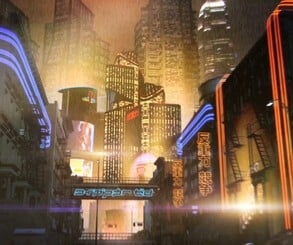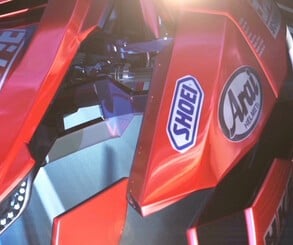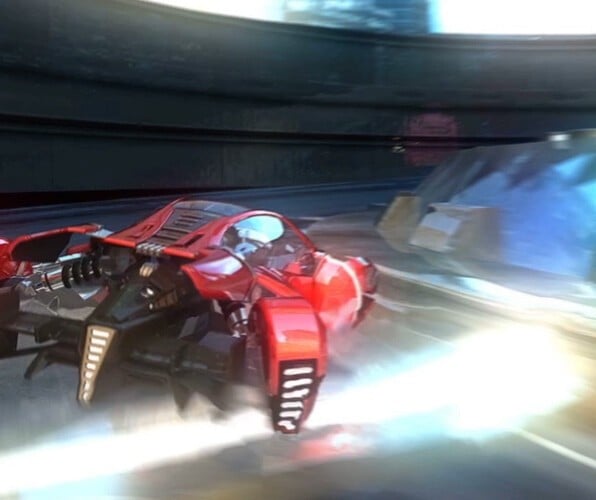PS4 sadly didn't get a WipEout at launch, although it did get the excellent Omega Collection in 2017, a pack which pulled together content from WipEout HD and the aforementioned PS Vita entry and holds the distinction of being the only instalment to top the UK sales charts. Had things turned out a little differently, we could have been playing one of the most dramatic reimaginings of the series yet seen on PS4; an entry which would have retained the anti-gravity mechanics but evolved the on-track action into something closer to a traditional racing game.
The game we're talking about is WipEout Zero, but you'd be forgiven for not realising it (almost) existed, as it was only very recently revealed in the pages of WipEout Futurism, a new book celebrating the franchise. While rumours had swirled over a decade ago, we've never seen any concrete information about the cancelled entry – until now.
Keen to learn more about the game, we contacted Karl Jones. Jones joined Psygnosis as a QA tester in 2000 and eventually rose to the position of lead designer, helping to shape multiple entries in the WipEout canon.
"We'd learned a lot from making the last few versions of the game," he tells us when describing the situation which led to the birth of WipEout Zero. "We'd gotten to the point where making WipEout games just came naturally to us. We all knew our roles, we knew what needed to be done, and we all just did it. We'd been together so long we all kind of synced up on what we thought the next one should be. Because we'd been in perpetual conversations about it, formal and informal, WipEout 'Next' (or WipEout 'X' as it was often referred to) was always a topic of conversation."
Images: Read-Only Memory / Studio Liverpool
At the forefront of Jones' mind was the need to make WipEout more commercially viable – a key concern when you consider the fickle business of high-level game development is based on revenue rather than pumping out cult classics. WipEout was popular but wasn't in the same league as other racing series in terms of commercial performance. To this end, the idea was to create a "rival" anti-grav racing league which would still be rooted in the world of WipEout, but with different craft to control – craft closer to what people drive today, at least in terms of their shape.
While Jones is clearly in love with the series (he helped shape some of the best WipEout outings, after all), he began to feel that the subject matter – ships which float above the track rather than sit directly on it – meant that millions of casual players would dismiss the games and simply pick Forza, Need for Speed and Gran Turismo instead. After all, these franchises have real-world and instantly familiar cars on their covers; if you fancy a racing game and you're not clued up on what WipEout is, then you're never going to pick one with a spaceship on the front.
In addition to this concern, Jones and the team at Studio Liverpool were also keen to make the games more accessible in order to grow the audience and establish the long-term future of the franchise. "We'd taken conscious steps to make 2048 more accessible than any previous WipEout," he says.
Taking inspiration from anime and traditional car racing franchises, WipEout Zero would have represented a significant shift for the franchise. "The ship designs became very car-like," Jones says. "They were still anti-gravity – so no wheels – but at a glance, they looked like futuristic cars, not spaceships. We thought that would make a big difference to people's perception that it is actually a racing game. Tracks were so much wider and they were mainly on roads, which again helped that relatability that we needed so much. We didn't get far enough along to even introduce weapons, but to be honest, it felt so nice without them, there's a chance we may not have included them."
Jones and his team may been undecided on weaponry, but that doesn't mean WipEout Zero wouldn't have afforded the player some offensive capabilities. "The cars articulated to react to the ground and absorb impacts," he explains. "They were never meant to be like Transformers, but they could do things like throw a very short-range melee attack – a bit like a pinball bumper – to rivals and could also do things like brace for impact. This was looking like it was going to be a great feature for the vehicles and a kind of evolution of the airbrakes, but we were very conscious not to get carried away with it; ideas like that can be a slippery slope, and before you know it, you've lost sight of the reasons for their inclusion."
Jones is keen to point out that, despite the car-like vehicles, WipEout Zero would have eventually evolved into something a little more familiar to long-term fans. "The idea was for the player to get so far into the game and then start seeing imagery and designs that were more in line with typical WipEout games. So, the dart ships and maybe projectiles. We'd hoped the familiarity of cars and streets would be a nice 'Trojan horse' approach for us to get a more traditional WipEout into peoples' hands." He adds that while the teams involved in this racing league would be all-new, there would be crossover from the main series, with constructors like Fiesar signing up to participate in the rival league as the game progressed.
Unfortunately, Sony closed Studio Liverpool in 2012, bringing all development to an end. "We might've been successful, who knows," laments Jones. "I'm pretty gutted that Zero never got finished. It was showing so much promise, so early on."

"I’m Pretty Gutted It Never Got Finished" - The Untold Story Of WipEout Zero
"We all kind of synced up on what we thought the next one should be"








